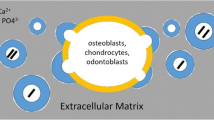Abstract
Hypophosphatasia is a hereditary disorder characterized by a deficiency of serum and bone alkaline phosphatase (ALP) activity and defective skeletal mineralization. It is caused by a loss of function mutations in the tissue nonspecific ALP gene (TNSALP) encoding the tissue nonspecific alkaline phosphatase. A 4-year-and-8-month-old girl presented with premature exfoliation of the anterior incisors and canines. Very low ALP level (27 IU/ml) suggested the diagnosis of hypophosphatasia, which was supported by an elevated urine phosphoethanolamine/Cr of 84 μmol/mmol (reference range, <25 μmol/mmol) and serum pyridoxal-5′-phosphate of 393 μg/L (reference range, 3.6–18 μg/L). The phenotype of the patient was subsequently classified as mild childhood hypophosphatasia. TNSALP gene sequencing revealed the homozygous c.382 G > A (p.V128M) mutation. This mutation was previously observed in a series of patients with severe hypophosphatasia, pointing out the possible role of other genetic or environmental factors in the modulation of the hypophosphatasia phenotype.

Similar content being viewed by others
References
Fraser D (1957) Hypophosphatasia. Am J Med 22:730–746
Mornet E (2007) Hypophosphatasia. Orphanet J Rare Dis 2:40
Mornet E (2008) Hypophosphatasia (review). Best Pract Res Clin Rheumatol 22(1):113–127
Mornet E, Yvard A, Taillandier A, Fauvert D, Simon-Bouy B (2011) A molecular-based estimation of the prevalence of hypophosphatasia in the European population. Ann Hum Genet 75:439–445
Mumm S, Jones J, Finnegan P, Henthorn PS, Podgornik MN, Whyte MP (2002) Denaturing gradient gel electrophoresis analysis of the tissue nonspecific alkaline phosphatase isoenzyme gene in hypophosphatasia. Mol Genet Metab 75(2):143–153
Reibel A, Manière MC, Clauss F, Droz D, Alembik Y, Mornet E, Bloch-Zupan A (2009) Orodental phenotype and genotype findings in all subtypes of hypophosphatasia. Orphanet J Rare Dis 4:6
Turan S, Topcu B, Gokce I, Guran T, Atay Z, Omar A, Akcay T, Bereket A (2011) Serum alkaline phosphatase levels in healthy children and evaluation of alkaline phosphatase z-scores in different types of rickets. J Clin Res Pediatr Endocrinol 3(1):7–11
Whyte MP, Mahuren JD, Vrabel LA, Coburn SP (1985) Markedly increased circulating pyridoxal-5′-phosphate levels in hypophosphatasia. Alkaline phosphatase acts B6 metabolism. J Clin Invest 76:752–756
Whyte MP (1994) Hypophosphatasia and the role of alkaline phosphatase in skeletal mineralization. Endocr Rev 15:439–461
Zurutuza L, Muller F, Gibrat JF, Taillandier A, Simon-Bouy B, Serre JL, Mornet E (1999) Correlations of genotype and phenotype in hypophosphatasia. Hum Mol Genet 8:1039–1046
Author information
Authors and Affiliations
Corresponding author
Rights and permissions
About this article
Cite this article
Haliloglu, B., Guran, T., Atay, Z. et al. Infantile loss of teeth: odontohypophosphatasia or childhood hypophosphatasia. Eur J Pediatr 172, 851–853 (2013). https://doi.org/10.1007/s00431-012-1868-4
Received:
Accepted:
Published:
Issue Date:
DOI: https://doi.org/10.1007/s00431-012-1868-4




